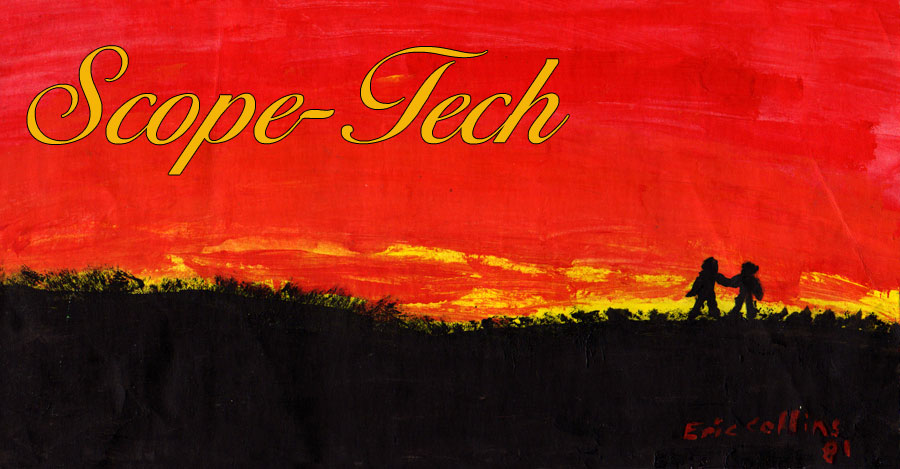
St. Pierre & Miquelon - On the heels of our annexation of these two former French island outposts in the Western hemisphere, SCOPE-TECH is pleased to announce our newest product upgrade, the Flying Monkey Version 2.0.
Attempting to overcome the problems with the original product, such as the wingspan necessary to provide flight proved structurally weak and the fact that the V-1's were prone to go AWOL, SCOPE-TECH's scientist went back to the drawing board. Realizing the inherent problems of a pure biological solution to the problem, our researchers settled on a psychological / cybernetic / mechanical solution.
First off, using certain "conditioning" routines, we implanted a humming bird's flight instincts into the simians' brains. Next, we had to design the flying apparatus. Having learned our lesson the first time, we tossed out Da Vinci's flying wings. And while the helicopter and autogyro (like "Little Nelly" in James Bond's You Only Live Twice) concepts were promising, the whirling blades were not appropriate (think Cusinart). Luckily, TNN had been showing a number of Bond movies over Christmas, and the jetpack idea from Thunderball proved to be the winner.
Attempting to overcome the problems with the original product, such as the wingspan necessary to provide flight proved structurally weak and the fact that the V-1's were prone to go AWOL, SCOPE-TECH's scientist went back to the drawing board. Realizing the inherent problems of a pure biological solution to the problem, our researchers settled on a psychological / cybernetic / mechanical solution.
First off, using certain "conditioning" routines, we implanted a humming bird's flight instincts into the simians' brains. Next, we had to design the flying apparatus. Having learned our lesson the first time, we tossed out Da Vinci's flying wings. And while the helicopter and autogyro (like "Little Nelly" in James Bond's You Only Live Twice) concepts were promising, the whirling blades were not appropriate (think Cusinart). Luckily, TNN had been showing a number of Bond movies over Christmas, and the jetpack idea from Thunderball proved to be the winner.
 Due to the unholy smell produced by burning monkey / burning monkey hair, the engine pods are mounted on telescoping boom arms from the main pack. This also helps shield the fuel supply and the electronic systems from the heat generated by the Rolls Royce engines. Contracting with the premier manufacturer of jet turbine engines also allows us to mount the famous hood ornament on their helmets, which is just cool. The engines thrust vectoring nozzles are controlled via a cybernetic interface and a "head's up" display in the helmet. While flight time / distance vary based on factors including height, distance, speed, wind, and weight, in "directed hovering" mode, distances of 15 miles and flight times of 30 minutes are not uncommon. This can be extended with a variety of schemes:
Due to the unholy smell produced by burning monkey / burning monkey hair, the engine pods are mounted on telescoping boom arms from the main pack. This also helps shield the fuel supply and the electronic systems from the heat generated by the Rolls Royce engines. Contracting with the premier manufacturer of jet turbine engines also allows us to mount the famous hood ornament on their helmets, which is just cool. The engines thrust vectoring nozzles are controlled via a cybernetic interface and a "head's up" display in the helmet. While flight time / distance vary based on factors including height, distance, speed, wind, and weight, in "directed hovering" mode, distances of 15 miles and flight times of 30 minutes are not uncommon. This can be extended with a variety of schemes:The first is an optional lifting wing attachment that greatly extends the horizontal flight distances, but they are cumbersome and make directional hovering more difficult.
The second method is an in-flight refueling capability from our fleet of refueling airships. A special gas caps prevents those damn dirty apes working at CITGO from helping a wayward soldier escape.
Our third method is to reduce the weight of the biological just before liftoff. Like birds, they "flush their systems" just before takeoff to reduce weight. As with racehorses, we used Pavlovian training, but we flash a special picture in their helmet's head's up display. This also reduces the strafing that was far too common with the Mach I's.
We call this scheme, "Monkey see. Monkey doo."

3 comments:
Cerebral Monkey Doodie post- always good for a chuckle. Nice work.
Monkey see. Monkey doo. Ewwwww.
Like I said before, flying monkeys would be even worse than birds. You know what birds can do to a car.... Blah.
Was there not an episode of "Gilligan's Island" where the chimp stole the jet-pack and freed himself from the isle and stranding (again) our cast of castaways?
Post a Comment